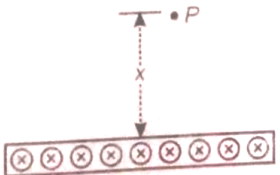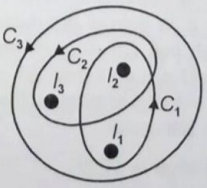The magnetic flux density B at a distance r from a long straight rod carrying a steady current varies with r as shown in figure.


Consider the three closed loops drawn using solid line in the magnetic field (magnetic field lines are drawn using dotted line) of an infinite curent-carrying wire normal to the plane of paper as shown.
Rank the line integral of the magnetic field along each path in order of increasing magnitude :
(1) 1> 2>3
(2) 1= 3>2
(3) 1=2=3
(4) 3> 2>1
A positive charge 'q' of mass 'm' is, moving along the +x axis. We wish to apply a uniform magnetic field B for time t so that the charge reverses its direction crossing the y-axis at a distance 'd'. Then
1.
2.
3.
4.
A rectangular loop of sides 10 cm and 5 cm carrying a current I of 12 A, is placed in different orientation as shown in figure below.
(A)
(B)
(C)
(D)
If there is a uniform magnetic field of 0.3 T in the positive Z-direction in which orientations the loop will be (i) stable equilbrium and (ii) unstable equilibrium:
1. A and D respectively
2. B and D respectively
3. B and C respectively
4. A and B respectively
A proton (mass m) accelerated by a potential difference V flies through a uniform transverse magnetic field (B). The field occupies a region of space of width 'd'. If 'a' be the angle of deviation of proton from initial direction of motion (Fig), the value of sin will be:
1.
2.
3.
4.
| 1. | infinite | 2. | zero |
| 3. | \( \frac{\mu_0 2 i}{4 \pi} ~\text{T} \) | 4. | \( \frac{\mu_0 i}{2 r} ~\text{T} \) |
A long straight, solid metal wire of radius 2 mm carries a current uniformly distributed over its circular cross-section. The magnetic field induction at a distance 2 mm from its axis is B. Then, the magnetic field induction at distance 1 mm from axis will be
(1) B
(2) B/2
(3) 2B
(4) B
Figure shows a cross-section of a large metal sheet carrying an electric current along its surface. The current in a strip of width dl is (Kdl) where K is a constant. Find the magnetic field at a point P at a distance x from the metal strips

1.
2.
3.
4.
Three infinitely-long conductors carrying currents lie perpendicular to the plane of the paper as shown below.

If the value of integral for the loops in the units of N/A, respectively, then
1. = 3 A into the paper
2. = 3 A out of the paper
3. = 0
4. = 1 A out of the paper
A cylindrical wire of radius R is carrying current i uniformly distributed over its cross-section. If a circular loop of radius r is taken as amperian loop, then the variation value of over this loop with radius 'r' of loop will be best represented by:
(1)
(2)
(3)
(4)
















